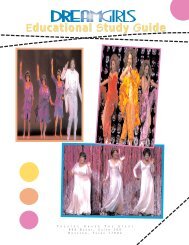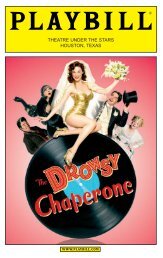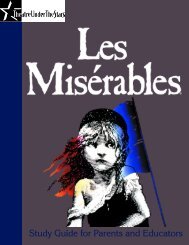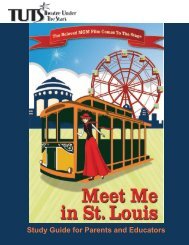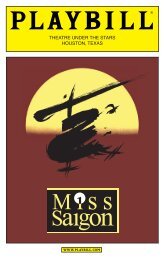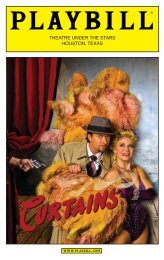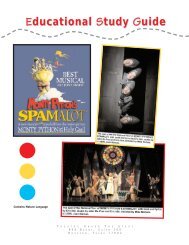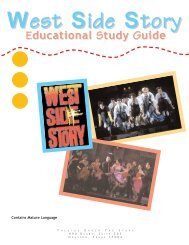THEATRE UNDER THE STARS • 2011/12 STUDY GUIDE
THEATRE UNDER THE STARS • 2011/12 STUDY GUIDE
THEATRE UNDER THE STARS • 2011/12 STUDY GUIDE
Create successful ePaper yourself
Turn your PDF publications into a flip-book with our unique Google optimized e-Paper software.
<strong><strong>THE</strong>ATRE</strong> <strong>UNDER</strong> <strong>THE</strong> <strong>STARS</strong> <strong>•</strong> <strong>2011</strong>/<strong>12</strong> <strong>STUDY</strong> <strong>GUIDE</strong><br />
LA CAGE AUX FOLLES <strong>•</strong> APRIL 24 – MAY 6, 20<strong>12</strong> <strong>•</strong><br />
<strong>THE</strong> HOBBY CENTER<br />
RATED<br />
PG-13<br />
1
<strong><strong>THE</strong>ATRE</strong> <strong>UNDER</strong> <strong>THE</strong> <strong>STARS</strong> <strong>•</strong> <strong>2011</strong>/<strong>12</strong> <strong>STUDY</strong> <strong>GUIDE</strong><br />
TEXAS ESSENTIAL KNOWLEDGE AND SKILLS<br />
English Language Arts and Reading<br />
Grade 8: 110.20 (14, 15, 16, 17, 18, 22, 23, 24, 25)<br />
English I: 110.31 (13, 14, 15, 16, 20, 21, 22, 23)<br />
English II: 110.32 (13, 14, 15, 16, 20, 21, 22, 23)<br />
English III: 110.33 (13, 14, 15, 16, 20, 21, 22, 23)<br />
English IV: 110.34 (13, 14, 15, 16, 20, 21, 22, 23)<br />
Social Studies<br />
United States History since Reconstruction: 113.41 (10, 25, 26, 29)<br />
Music<br />
Grade 8: 117.39 (6)<br />
Level I: 117.60 (6)<br />
Level II: 117.61 (6)<br />
Level III: 117.62 (6)<br />
Level IV: 117.63 (6)<br />
Theatre<br />
Grade 8: 117.40 (5)<br />
Level I: 117.64 (4, 5)<br />
Level II: 117.65 (4, 5)<br />
Level III: 117.66 (4, 5)<br />
Level IV: 117.67 (4,5)<br />
Please visit http://ritter.tea.state.tx.us/rules/tac/ for more information.<br />
2
Photo courtesy of Joan Marcus 2010.<br />
<strong><strong>THE</strong>ATRE</strong> <strong>UNDER</strong> <strong>THE</strong> <strong>STARS</strong> <strong>•</strong> <strong>2011</strong>/<strong>12</strong> <strong>STUDY</strong> <strong>GUIDE</strong><br />
A Brief Summary<br />
Georges and his lover, Albin, who stars as Zaza at their drag<br />
nightclub, La Cage aux Folles, have lived happily together for many<br />
years. Problems arise when Georges’ son, Jean-Michel, announces<br />
he is engaged to Anne Dindon who is the daughter of a well-known<br />
anti-gay politician. Anne’s parents want to meet Jean-Michel’s mother<br />
and father. Jean-Michel wants to keep Albin away from the Dindons.<br />
Albin is hurt and insists on making an appearance in the comical<br />
meeting of in-laws. In the end, the Dindons are forced to allow Anne<br />
to marry Jean-Michel in order to keep their reputation. For a more<br />
detailed synopsis, see pages 6 and 7 of this study guide.<br />
PARENTAL <strong>GUIDE</strong>LINES<br />
La Cage Aux Folles contains some sexual references and suggestive costumes. Some material may be inappropriate for<br />
children under 13. TUTS gives the show a movie rating of PG-13.<br />
Adult Language<br />
The word bitch is sung in Mascara.<br />
Violence<br />
Francis wears a neck brace in Act I and a sling in Act II and claims it’s because he’s dating Hanna.<br />
Drugs/Alcohol<br />
Georges and Albin drink brandy at the café. Georges, Albin, Jean-Michael and the Dindons drink wine and champagne<br />
at their apartment and Jacquline’s resturant.<br />
Sexual References<br />
La Cage is a drag night club. Les Cagelles and Zaza are male drag performers who often wear revealing and skimpy<br />
outfits. They perform a Cabaret-style show and their numbers, We Are What We Are, Mascara, La Cage Aux Folles<br />
and the Finale, contain sexual innuendos, sexual references and suggestive dancing. George and Albin are homosexual<br />
partners. Jean-Michael and Anne kiss while walking along the beach. Jean-Michael’s mother is described as a whore. In<br />
I Am What I Am, Albin sings about how he feels as a drag performer. Georges’ dinner plates have naked men on them.<br />
The Dindons dress up in the Les Cagellas costumes to escape the press at the end of the musical.<br />
RATED<br />
PG-13<br />
3
<strong><strong>THE</strong>ATRE</strong> <strong>UNDER</strong> <strong>THE</strong> <strong>STARS</strong> <strong>•</strong> <strong>2011</strong>/<strong>12</strong> <strong>STUDY</strong> <strong>GUIDE</strong><br />
TABLE OF CONTENTS<br />
FRONT ROW: A Little More Mascara<br />
STORY BEHIND <strong>THE</strong> STORY<br />
MOVIE VS MUSICAL<br />
CHARACTER DESCRIPTIONS<br />
CURTAIN CALL: Learning Activities<br />
WHO’S WHO: GEORGE HAMILTON<br />
LOOKING BACK: 1970S FAMILY VALUES<br />
HISTORY: DRAG<br />
LEARNING ACTIVITIES<br />
......... 5<br />
......... 5<br />
......... 6<br />
......... 9<br />
......... 10<br />
......... 11<br />
......... <strong>12</strong><br />
13 .........<br />
14 .........<br />
15 .........<br />
16 .........<br />
7/8 .........<br />
TUTS <strong>STUDY</strong> <strong>GUIDE</strong><br />
TUTS creates online study guides for use by educators and parents in an effort to enhance<br />
and build upon students’ theatrical experiences. These study guides contain background<br />
information, historical facts, discussion questions, project ideas and learning activities<br />
to encourage students to engage in analysis, research and personal reflection that will<br />
hopefully create life-long appreciation and enjoyment of musical theatre.<br />
CENTER STAGE: I Am What I Am<br />
DETAILED SYNOPSIS<br />
BACKSTAGE: About Musical Theatre<br />
A BRIEF HISTORY<br />
RECIPE FOR CREATING A MUSICAL<br />
<strong><strong>THE</strong>ATRE</strong> ETIQUETTE<br />
ABOUT TUTS<br />
4
FRONT ROW: A Little More Mascara<br />
Story Behind the Story<br />
La Cage Aux Folles is based on Jean Poiret’s 1973 French play of the<br />
same name. The musical was also a loose adaptation of the 1978 film La<br />
Cage Aux Folles. Film producer Allen Carr wanted to make his Broadway<br />
debut with a La Cage musical based on the film. He could, however, only<br />
get the rights to the original play, so that is the version he used. He hired a<br />
top notch creative team, but when executive producers Fritz Holt and Barry<br />
Brown came on board, they fired Carr’s original creative team in favor<br />
of recruiting Gypsy director Arthur Laurents, book writer Harvey Fierstein,<br />
and Hello, Dolly! and Mame composer and lyricist Jerry Herman. Fierstein<br />
was a gay rights activist, while Laurents was not a fan of gay-themed<br />
projects, but with Herman as the moderator, the three were able to work<br />
together.<br />
The team was concerned, however, at the lack of affection between Albin<br />
and Georges, since it is a love story. Their compromise came in the form<br />
of a kiss on both cheeks shared by the characters; a French custom that<br />
is more acceptable in the public eye. Despite the fact that La Cage was<br />
opened in the middle of the AIDS epidemic, when much of the public<br />
was homophobic, the show did better than its creative team could have<br />
imagined.<br />
La Cage opened on Broadway on August 21, 1983 and ran for four years,<br />
racking up six Tony Awards including Best Musical, and three Drama Desk<br />
Awards. La Cage has been revived numerous times internationally. The most<br />
recent revival, on Broadway in 2010, featured TUTS’ Humphreys School of<br />
Musical Theatre alumnus Logan Keslar. TUTS has produced La Cage once<br />
before in 1992.<br />
Photo courtesy of neoseeker.com<br />
Photo courtesy of moviereview.com<br />
Movie vs Musical<br />
Arthur Laurents<br />
The 1978 movie version of La Cage Aux Folles is a French-Italian<br />
adaptation of Poiret’s play. This foreign film had to be dubbed into English<br />
by the original cast into English and shares the same basic plot line as the<br />
musical. La Cage won the Golden Globe for best foreign film and was the<br />
number one foreign film to be released in the U.S. for many years. The film<br />
does not feature any of the same music as the musical since Carr could not<br />
get the rights to use it.<br />
Two sequels were made to the film: La Cage Aux Folles II in 1980 and La<br />
Cage Aux Folles 3 - Elle’ se Marient in 1985, neither of which did very<br />
well in the U.S. In 1996, Robin Williams and Nathan Lane starred in an<br />
American remake of the film, The Birdcage. The Birdcage kept the same<br />
basic plot line, but altered a number of details and moved the story to<br />
Miami Beach. The movie also featured several Stephen Sondheim songs,<br />
but none of the songs from the musical version of La Cage Aux Folles.<br />
Photo courtesy of broadwayworld.com<br />
Photo courtesy of guardian.co.ukPhoto courtesy of topnews.in<br />
Harvey Fierstein<br />
Jerry Herman<br />
5
Photo courtesy of Joan Marcus 2010.<br />
FRONT ROW: A Little More Mascara<br />
Character Descriptions Characters<br />
Anne Dindon<br />
Jean-Michel’s fiancée who<br />
loves him despite her parents’<br />
disapproval.<br />
Albin (Zaza)<br />
Georges long-time partner and<br />
Jean-Michel’s mother figure. He is<br />
a well-known star who performs<br />
at La Cage as Zaza. He pretends<br />
to be Jean-Michel’s mother when<br />
Sybil, Jean-Michel’s birth mother,<br />
cannot come to the dinner.<br />
Photo courtesy of playbill.com<br />
Jacob<br />
Georges and Albin’s live-in butler<br />
who has dreams of starring in<br />
La Cage. He accidentally burns<br />
Jean-Michel’s important dinner.<br />
Jean-Michel<br />
Mrs. Dindon<br />
Anne’s mother and Mr. Dindon’s<br />
wife. She does not want Anne to<br />
marry Jean-Michael because of<br />
his family and the bad publicity<br />
that would come with the union.<br />
Son of Georges and his birth<br />
mother Sybil, he was raised by<br />
Georges and Albin. He wants to<br />
marry Anne Dindon, but he needs<br />
her parents to approve of his<br />
family before they can wed.<br />
Photo courtesy of Joan Marcus 2010.<br />
Photo courtesy of Joan Marcus 2010.<br />
Mr. Dindon<br />
Anne’s father, anti-gay activist and the<br />
head of the “Tradition, Family and Morality<br />
Party.” He does not want Anne to marry<br />
Jean-Michael because it would tarnish his<br />
reputation.<br />
Georges<br />
Jean-Michel’s father and Albin’s<br />
long-time partner. He owns La<br />
Cage and often plays the role<br />
of the mediator, trying to keep<br />
peace and keep everyone happy.<br />
Jacqueline<br />
Albin’s friend and restaurant<br />
owner. She helps blackmail the<br />
Dindons.<br />
Photo courtesy of Joan Marcus 2010.<br />
6
Photo courtesy of Joan Marcus 2010.<br />
ACT ONE<br />
The master of ceremonies, Georges, welcomes the<br />
audience to his St. Tropez drag nightclub, La Cage Aux<br />
Folles. The Cagelles, his chorus line of drag performers,<br />
introduce themselves to the audience (We Are What<br />
We Are). Georges and his partner, Albin, have lived<br />
together for years in an apartment above La Cage with<br />
their butler Jacob. Albin is a drag queen and the star<br />
performer of La Cage aux Folles.<br />
Albin prepares to perform while dramatically arguing<br />
that Georges is going to leave him after twenty years<br />
together (Mascara). Georges’ son, Jean-Michel, the<br />
product of an experimental affair with a woman named<br />
Sybil, comes home with the news that he is engaged<br />
to Anne Dindon. Georges does not approve of the<br />
engagement right away, but Jean-Michel professes to his<br />
father that he is in love with Anne (With Anne on My<br />
Arm).<br />
Anne’s father, however, is the head of an organization,<br />
the “Tradition, Family and Morality Party,” whose primary<br />
goal is closing the drag clubs in town. Anne’s parents<br />
want to meet Jean-Michel’s parents, but Jean-Michel has<br />
been lying to Anne about his parents. Jean-Michel begs<br />
Georges to redecorate the apartment and replace Albin<br />
with Sybil for the visit, even though Sybil has barely seen<br />
him since birth.<br />
Photo courtesy of Joan Marcus 2010.<br />
CENTER STAGE: I Am What I Am<br />
Detailed Synopsis<br />
Photo courtesy of broadwayworld.com<br />
When Albin returns from performing, Georges suggests<br />
that they take a walk to discuss the matter. The pair<br />
almost run into Jean-Michel and Anne, but Jean-Michel<br />
hurries Anne away before she figures out what’s going<br />
on. (With Anne on My Arm Reprise).<br />
Georges attempts to soften the blow of Jean-Michel’s<br />
requests to Albin (Song on the Sand), but Albin has to<br />
make it back to La Cage in time for the next show before<br />
Georges is able to break the bad news about not being<br />
invited to dinner.<br />
Albin takes the stage once more as Zaza (La Cage Aux<br />
Folles) and while he is performing, Georges and Jean-<br />
Michel quickly redecorate the house. As Albin is changing<br />
for his next number, he notices the two carrying his gowns,<br />
and Georges is forced to finally tell Albin of Jean-<br />
Michel’s dinner party plan.<br />
Albin does not get mad but rather excuses himself to<br />
return to the stage. Half way through the song, he sends<br />
Les Cagelles away and sings alone to convey his distress<br />
and state that he refuses to change for anyone (I Am<br />
What I Am). At the end of the song, he throws his wig at<br />
Georges and storms off.<br />
7
CENTER STAGE: I Am What I Am<br />
ACT TWO<br />
Detailed Synopsis<br />
Georges finds Albin the next morning and apologizes<br />
(Song on the Sand Reprise). Georges suggests to Albin<br />
that he dress up for dinner as a macho “Uncle Al”.<br />
Even though Albin is still upset, he reluctantly agrees to<br />
act like a heterosexual for Jean-Michel, and Georges<br />
attempts to teach him how to act more like a man<br />
(Masculinity).<br />
Photo courtesy of Joan Marcus 2010.<br />
Back at Georges’ redesigned apartment, “Uncle Albert”<br />
is reveled to Jean-Michel. He does not like the idea of<br />
“Uncle Al” or the fact that Albin is gay. Georges angrily<br />
reminds Jean-Michel of how good Albin has been to<br />
him over the years (Look Over There). They receive a<br />
telegram from Sybil saying that she is not coming, but<br />
before Albin and Georges can tell Jean-Michel, Anne’s<br />
parents arrive (Dishes).<br />
Attempting to save the dinner, Albin comes out as Jean-<br />
Michel’s forty-year-old mother. Jacob burns the dinner, so<br />
a trip to the restaurant, Chez Jacqueline, which belongs<br />
to a friend of Albin and Georges, is arranged.<br />
At the restaurant, Jacqueline does not realize who Albin<br />
is pretending to be, or what’s going on, so she asks Albin<br />
Photo courtesy of Joan Marcus 2010.<br />
Photo courtesy of nymag.com<br />
to sing as Zaza.<br />
After some hesitation, Albin agrees to sing (The Best of<br />
Times). The restaurant patrons, including Anne’s mother<br />
enthusiastically take part in the song. With his usual<br />
performance vigor, Albin tears off his wig at the song’s<br />
end, ruining his disguise and reveling his true identity.<br />
Georges, Albin, Jean-Michel and their guests rush back<br />
to the apartment where the Dindons plead with Anne to<br />
abandon her fiancé because they are appalled by his<br />
homosexual parents. Anne states that she is in love with<br />
Jean-Michel and refuses to leave him. Jean-Michel, now<br />
ashamed of the way he treated Albin, apologizes to his<br />
parents (Look Over There Reprise).<br />
Anne’s parents attempt to leave Georges and Albin’s<br />
apartment, which is located above the club, but are<br />
blocked by Jacqueline. Jacqueline has come with the<br />
press to photograph the anti-homosexual Dindons at La<br />
Cage and with Zaza. Mr. Dindon is furious, but Georges<br />
and Albin agree to help him avoid the press if he gives<br />
his blessing for Anne and Jean-Michel to marry. Georges<br />
helps the Dindons escape through La Cage Aux Folles<br />
dressed in drag and posing as members of the nightclub’s<br />
revue (Finale).<br />
8
CURTAIN CALL: Learning Activities<br />
Who is George Hamilton?<br />
Who’s Who: George Hamilton & Christopher Sieber<br />
George Hamilton is noted for his dashing, sporting, jet-setter image and perpetually<br />
bronzed skin tones in commercials, dramatic and comedic film roles and reality shows.<br />
His first film, a lead in Crime & Punishment, USA (1959). He was the recipient of<br />
a Golden Globe for “Most Promising Newcomer” as well as being nominated for<br />
“Best Foreign Actor” by the British Film Academy (BAFTA). This led to a series of film<br />
showcases such as Home from the Hill, All the Fine Young Cannibals, Light in the Piazza<br />
and Two Weeks in Another Town. He performed several roles in numerous films but<br />
is best known for MGM films in the 1960s’ Where the Boys Are. Hamilton made two<br />
memorable bio-pics: Your Cheatin’ Heart in 1964, in which he portrayed the countrywestern<br />
music legend Hank Williams and in 1971, Evel Knievel, the life story of the<br />
motorcycle daredevil. A wonderful comeback for him came in the disco-era Dracula<br />
spoof Love at First Bite (1979). Nominated for a Golden Globe as the campy neckbiter,<br />
he continued on the parody road successfully with Zorro, the Gay Blade (1981)<br />
in the very best Mel Brooks tradition. This renewed popularity led to a one-year stint<br />
on “Dynasty” (1981) and a string of fun, self-mocking commercials. In 1989 he started<br />
a line of skin-care products and a chain of tanning salons. On the tube he can still pull<br />
off a good time, whether playing flamboyant publisher William Randolph Hearst in<br />
Rough Riders (1997) (TV), playing Santa Claus in A Very Cool Christmas (2004) (TV).<br />
He has broken through the “reality show” ranks by hosting “The Family” (2003) and<br />
participating in the second season of ABC’s “Dancing with the Stars” (2005/I), where his<br />
charm and usual impeccable tailoring scored higher than his limberness. Hamilton was<br />
honored with a star on the Hollywood Walk of Fame in 2009, on his 70th birthday.<br />
Who is Christopher Sieber?<br />
Two-time Tony nominee Christopher Sieber plays the role of Albin/Zaza in La Cage aux<br />
Folles. Nominated for his performances in Shrek and Spamalot, Christopher Sieber’s<br />
Broadway credits also include Thoroughly Modern Millie, Into the Woods, Beauty and<br />
the Beast, Triumph of Love and A Christmas Carol. His other New York stage credits<br />
include Off-Broadway’s The Kid, Avow and The Boys in the Band. His television and film<br />
credits include “Morning Glory,” “Pushing Daisies,” “Johnny and the Sprites,” “See You<br />
in September,” “It’s All Relative,” “Two of a Kind,” “Sex and the City,” “Ed,” “Guiding<br />
Light,” “All My Children” and “Another World.”<br />
Learning Activities<br />
Imagine and Write<br />
Imagine that like George Hamilton’s The George and<br />
Alana Show, you have the opportunity to have your own<br />
talk show. Would you have a cohost, and who would<br />
it be? What kinds of things would you talk about and<br />
feature? Would you invite any guests or music artists to<br />
perform? What time of day would your show come on?<br />
Write about what your talk show would be like.<br />
Imagine that it is 40 years from now and you have<br />
become famous. Write a brief biography for yourself.<br />
What have you accomplished? What are you famous<br />
for? Are you married? Do you have any kids? What do<br />
you want the public to know about you? Do you support<br />
any causes?<br />
Creation Challenge<br />
Photos courtesy of La Cage<br />
Think and Create<br />
Hamilton launched his own line of skin care products<br />
and a chain of tanning salons. Think about what kind<br />
of product or chain you would launch. Would you<br />
create clothes, sports equipment or a new invention<br />
altogether? Or would you open a new restaurant or<br />
hair salon chain? Create a brochure, commercial or<br />
presentation advertising your product or business.<br />
Think about what kind of marketing techniques you<br />
would use to make your product/business successful.<br />
Would you have a jingle or a catchy slogan? Then<br />
Create one and see if family and friends would want to<br />
buy your product/business.<br />
9
CURTAIN CALL: Learning Activities<br />
Looking Back: 1970s Family Values<br />
The Culture of the 1970s<br />
The war and social change that defined the 1960s continued into the 1970s and early<br />
1980s. The Vietnam War spurred anti-war marches on Washington and university campuses,<br />
which in turn led to the stereotype of peace-loving hippies whose lifestyle seemed popular<br />
in the 70s. [Women gained political power with the advent of Affirmative Action and the<br />
idea that minorities should have quality education and employment rose to the forefront of<br />
political debate.] Gay rights was a hot topic with the Stonewall Rebellion in 1969 and the<br />
first Pride Parade in 1970. The economy saw the worst recession in 40 years, and New<br />
York lost almost 10% of its population as people moved out of the city due to budget cuts,<br />
pay cuts and infrastructure rot.<br />
Picture of the 1970s Family<br />
Although abortion was legalized in 1973 and the rising divorce rate left more women as<br />
single moms in the 1970s, families were still portrayed more traditionally and conservative<br />
in appearance. The Brady Bunch basically served as a comedic model for the acceptable<br />
contemporary family. Homosexual couples could not marry, nor could they adopt children,<br />
so it was extremely rare to see a child with homosexual parents.<br />
1970s Family Values Movements<br />
Family values were stressed in many homes, but television began to address taboo topics<br />
like sex, race, abortion, teenage pregnancy and homosexuality through shows like Saturday<br />
Night Live and All in the Family. The violence of the Vietnam War was broadcast on the<br />
news, bringing the fighting into families’ homes. This sort of shift in media and societal<br />
attitudes toward what was acceptable led to the creation of many groups similar to<br />
the Dindon’s “Tradition, Family and Morality Party.” These kind of family-value-based,<br />
conservative groups attempted to suppress moral permissiveness and return America to its<br />
traditional and conservative roots. The Family Planning Act, developed in 1970, broadened<br />
the role of government in family planning and served as turning point in the movement to<br />
re-strengthen families. It also established Planned Parenthood facilities. A Senate hearing,<br />
titled “American Families: Trends and Pressures,” was also held in 1973 and addressed<br />
statistically the state of the American family structure.<br />
Picture of Today’s Modern Family<br />
Today, like the ABC sitcom Modern Family, families come in all shapes and sizes. While same<br />
sex marriage is still not overtly supported by everyone, homosexuals can now get married in<br />
6 states and in Washington, D.C. Same-sex couples can also adopt children in more than 22<br />
states. Families no longer look to the Brady Bunch as their model, but rather they are free<br />
to change and live in whatever way is best for them.<br />
Compare and Contrast<br />
Compare and Contrast an episode of the Brady Bunch<br />
with an episode of Modern Family. Do you see the<br />
different family values in each show? How are the<br />
family structures the same? How are they different?<br />
Which show do you relate to more? Which show can<br />
your parents or grandparents relate to more?<br />
The Brady Bunch<br />
LGBT Marriage<br />
Movement<br />
ABC’s Modern Family<br />
Learning Activities<br />
Research and Discuss<br />
Research the “American Families: Trends and<br />
Pressures” senate hearing of 1973. What was<br />
discussed? Why was the hearing called? What impact<br />
did the hearing have on the family values movement?<br />
Are there any lasting impacts from the hearing that<br />
can still be seen today? Discuss your findings.<br />
Photos courtesy of nytimes.com<br />
10<br />
Photos courtesy of sitcomsonline.com<br />
Photos courtesy of sitcomsonline.com
Photo courtesy of logotv.com<br />
CURTAIN CALL: Learning Activities<br />
History: Drag Through the Ages<br />
Drag is the practice of men dressing up in women’s clothing. There are many different types of drag professionals,<br />
and contrary to popular belief, not all drag queens are homosexual or transgendered individuals. The most common<br />
reasons individuals do drag are for comedic, dramatic or satirical effect, artistic expression and show.<br />
When did Drag get its start? Drag on the Stage<br />
In the 13th century the church did not allow females to perform<br />
on stage, but did allow males to dress up and play women.<br />
Nearly all of the original Shakespeare plays were performed<br />
with an all-male cast and the same was true for early plays in<br />
China. Women were not allowed to perform on stage until 1660.<br />
Drag queens reached a bump in the road in the 1950s and 60s<br />
when a fear of communism spread through the U.S., and anything<br />
subversive was also deemed a security risk. Despite these<br />
setbacks, the first organized drag queen group, the Imperial<br />
Court, was formed in New York in 1964. Several police raids in<br />
1969 on the Stonewall Bar, the only gay bar in New York and<br />
home to a number of drag queens, including the Imperial Court,<br />
occurred before the drag queens and gay patrons began to fight<br />
back. The response to the Stonewall raid marked the first time<br />
the LGBT (Lesbian, Gay, Bisexual and Transgendered) community<br />
came together, and in 1970, the first Pride celebration was held.<br />
While drag was not widely accepted in 1970, it was no longer<br />
illegal and that allowed the practice to expand.<br />
Drag on TV<br />
Photos courtesy of dace-matherly.blogspot.com<br />
After vaudeville, drag queen performers made sure the art<br />
continued onto TV. Variety shows, like The Ed Sullivan Show and<br />
The Dean Martin Show, had drag queen acts on several episodes.<br />
Performers like Bob Hope and Milton Berle moved from vaudeville<br />
onto variety shows and other telvised specials with their comedy<br />
drag acts. The long-standing comedic bit about a man falling<br />
in love with a girl who turns out to be a man in drag has been<br />
featured on numerous sitcoms and TV shows. Self-proclaimed<br />
drag superstar, Rupaul Andre Charles has his own show, RuPaul’s<br />
Drag Race, which is the most popular drag show today. Drag<br />
Race is a competition between drag queens to determine who will<br />
be the next “drag superstar”. Competitions include everything<br />
from clothes to lip syncing.<br />
Starting as early as the 1910s, drag was found on vaudeville<br />
and Broadway. William Julian Dalton was a well-known drag<br />
queen who started performing at the age of 10, toured the<br />
vaudeville circuits and appeared on Broadway. Women liked<br />
his acts in vaudeville because his elaborate gowns and panache<br />
represented glamour. Bert Savoy was another performer of<br />
Dalton’s era whose drag style was rougher and focused more<br />
on pantomime of women. Nonetheless, up until vaudeville’s<br />
demise in the 1920s, drag queens had their own acts where<br />
they sang, danced and acted like females. Stage shows including<br />
contemporary drag began to appear in the 1970s with the<br />
underground musical The Rocky Horror Picture Show and rock<br />
acts like David Bowie and The New York Dolls. La Cage was<br />
the original breakthrough drag musical, but the roles of Edna in<br />
Hairspray and Angel in Rent are well known drag roles.<br />
Drag in Film<br />
Naturally drag queens moved from vaudeville and Broadway<br />
to film. Plenty of movies, including the La Cage series and The<br />
Birdcage, feature drag queens and drag performers. Classic<br />
drag movies, like Glen or Glenda starring Ed Wood and Some<br />
Like It Hot with Marilyn Monroe, Tony Curtis and Jack Lemon were<br />
made in the 1950s, while Victor/Victoria, starring Julie Andrews<br />
debuted in 1982. Drag movies have gained popularity in recent<br />
decades with films like Kinky Boots, Connie and Carla, the film<br />
versions of Rent and Hairspray. A Shade Before Pink and Priscilla<br />
Queen of the Desert have been well received by the public.<br />
Besides these drag based movies, comedic bits about drag or<br />
drag queen characters have appeared in countless movies.<br />
Photo courtesy of boston.com<br />
11
Photo courtesy of newyorktimeout.com<br />
CURTAIN CALL: Learning Activities<br />
Research and Discuss<br />
Activities<br />
Harvey Fierstein not only wrote La Cage Aux Folles,<br />
but he has performed in the show numerous times, most<br />
recently as Albin in the 2010 revival. Research Harvey<br />
Fierstein’s career. What other shows has he written?<br />
What other shows and/or movies has he performed<br />
in? How and why did he get started performing in La<br />
Cage? How long has he been performing in La Cage?<br />
Discuss your findings.<br />
Harvey Fierstein<br />
The Stonewall Rebellion was a turning point in the<br />
LGBT equality movement and led to the first Pride<br />
celebration. Research the Stonewall Rebellion. Who<br />
was involved? What happened? How did it start? How<br />
has it impacted the state of LGBT rights today? Has<br />
anything like the Stonewall Rebellion taken place in<br />
recent years? Discuss your findings.<br />
Online Resources<br />
Videos:<br />
La Cage 2010 (http://www.lacage.com/media.html)<br />
Rupaul’s Drag Race (http://www.logotv.com/shows/<br />
rupauls_drag_race/season_3/series.jhtml)<br />
Websites:<br />
La Cage the 2010 revival (http://www.lacage.com/index.<br />
html)<br />
HSMT’s Logan Keslar(http://broadwayworld.com/article/<br />
GYPSY_OF_<strong>THE</strong>_MONTH_Logan_Keslar_of_LA_CAGE_AUX_<br />
FOLLES_20100902)<br />
George Hamilton<br />
(http://www.biography.com/articles/George-<br />
Hamilton-9542321)<br />
1970s Family Values (http://sites.google.com/<br />
site/1970sus08/)<br />
Read and Compare<br />
Read “La Cage Aux Folles” the play, by Jean Poiret<br />
and Compare it to the musical. What parts are the<br />
same? What is different? Is the basic story line/plot<br />
the same in both? Which do you like better?<br />
Watch and Compare<br />
Watch the 1978 foreign film La Cage Aux Folles and<br />
Compare it to the musical. What is the same? What is<br />
different? Which did you enjoy more?<br />
Watch The Birdcage and Compare it to the musical La<br />
Cage Aux Folles. The Birdcage is the American version<br />
of the story, so are there any cultural differences?<br />
What else is the same? What else is different? Did<br />
you like the actor choices for The Birdcage? Which did<br />
you enjoy more? Which do you think tells the story<br />
better?<br />
Imagine and Write<br />
Imagine you are in Jean-Michel’s position and need<br />
to get someone else’s family, who is the complete<br />
opposite of your own, to approve of your family.<br />
Would you want to try and change your family?<br />
What kinds of things would you change about them?<br />
How would you convince them to go along with your<br />
changes? Write about what you would do.<br />
Imagine a time when a parent/teacher/family<br />
member/friend has embarrassed you. What<br />
happened? Why were you embarrassed? Was it really<br />
the other person’s fault? What did you do about the<br />
situation? Write a personal narrative describing the<br />
embarrassing situation.<br />
Think and Create<br />
Albin sings the song, I Am What I Am, to describe to his<br />
family and the audience that he is not ashamed of who<br />
he is or what he does. Think about who you are. What<br />
defines you? Is it your race, your age, your family or<br />
an activity you like to do? Create a poem or a song<br />
describing who you are to others.<br />
<strong>12</strong>
BACKSTAGE: About Musical Theatre<br />
A BRIEF HISTORY OF MUSICALS<br />
The origins of musicals can be traced back to 500 B.C. when the ancient Greeks first<br />
performed shows with song and dance. Looking forward into the 19th century, European<br />
operas and operettas began to influence American musical culture. In 1860, Laura Keene<br />
starred in the first musical “burlettz” (burlesque) The Seven Sisters. Six years later (1866), the<br />
first show to resemble a modern day musical, The Black Crook, premiered in New York City. In<br />
1907, Florenz Ziegfeld’s first revenue of popular songs, Follies, was born with lavish costumes,<br />
ornate sets and a display of star performers.<br />
Photo courtesy of broadwayworld.com<br />
<strong>THE</strong> BEGINNING<br />
Photo courtesy of valdosta.edu<br />
<strong>THE</strong> GOLDEN AGE<br />
<strong>THE</strong> 1920s & 1930s<br />
The 20s and 30s introduced famous composers such as Irving Berlin and George<br />
Gershwin, among others, to the musical scene. The collaboration of Jerome Kern, Oscar<br />
Hammerstein II and Ziegfeld led to the ground-breaking Show Boat in 1927, which<br />
integrated a book, score and songs to tell a narrative. In 1934, Cole Porter and Ethel<br />
Merman teamed up for Anything Goes. Richard Rodgers and Lorenz Hart opened The Boys<br />
from Syracuse in 1938, which was the first Broadway show to be adapted from a work of<br />
Shakespeare.<br />
The Golden Age stretched from 1940 to 1960. Rodgers and Hammerstein’s Oklahoma!<br />
was the first musical to incorporate dance and music into the plot in 1943. The hits kept<br />
coming in the following years with: Irving Berlin’s Annie Get Your Gun in 1946, Rodgers and<br />
Hammerstein’s South Pacific in 1949, Harold Prince’s The Pajama Game in 1954, Lerner and<br />
Loewe’s My Fair Lady in 1956 and West Side Story in 1957 with music by Leonard Bernstein,<br />
lyrics by Stephen Sondheim and choreography by Jerome Robbins. Highlights from the<br />
1960s include: How to Succeed in Business Without Really Trying in 1961, Fiddler on the Roof in 1964<br />
and Bob Fosse and Gwen Verdon’s Sweet Charity in 1966.<br />
CONTEMPORARY MUSICALS<br />
Beginning with Hair‘s rock music score in 1968, the age of Contemporary Musicals focused<br />
on unique concepts and ideas. Stephen Sondheim and director/producer Harold Prince<br />
became the musical leaders of their generation with the revolutionary Company in 1970.<br />
Andrew Lloyd Weber opened his controversial Jesus Christ Superstar in 1971. Michael<br />
Bennett’s acclaimed A Chorus Line debuted in 1975, its success even overshadowing<br />
Bob Fosse’s Chicago, which opened the same year. 42nd Street opened in 1980 and the<br />
adaptation of Victor Hugo’s novel, Les Miserables opened in 1987. Walt Disney’s animated<br />
film favorites were welcomed onto the stage with Beauty and the Beast in 1994 and Lion King<br />
in 1997. Meanwhile in 1996, Jonathan Larson’s Rent, broke all barriers and was put in a<br />
class of its own.<br />
MODERN MUSICALS<br />
Revivals of old shows have been frequent since 1977 , but there has been a host of new<br />
shows in the past decade. Mel Brooks’ musical about making a musical, The Producers<br />
opened in 2001 and Hairspray debuted with big haired Tracy in 2002. The extravagant<br />
version of OZ, Wicked premiered in 2003 and Avenue Q brought its puppet cast to life in<br />
2004. The 25th Annual Putnam County Spelling Bee allowed audiences into the minds of preteens<br />
in 2005 and Spring Awakening told the tale of teenagers in 2007. Most recently,<br />
Bono created the expensive and dangerous, yet thrilling Spider-Man in <strong>2011</strong>. The Book of<br />
Mormon, by Trey Parker, Robert Lopez and Matt Stone swept the <strong>2011</strong> Tonys with its fresh<br />
and funny story.<br />
Photo courtesy of musicals101.com<br />
Photo courtesy of theatremania.com<br />
Photo courtesy of nytimes.com<br />
13
BACKSTAGE: About Musical Theatre<br />
RECIPE FOR CREATING A MUSICAL<br />
STEP 1: Gather the Ingredients<br />
Combine the writer’s script with the composer’s songs and the lyricist’s<br />
lyrics to create a show that tells a story. The show itself should include<br />
several of the following elements: characters, conflict, humor, romance,<br />
costumes, sets, singing, dancing, animals, puppets and/or special<br />
effects. Meet with the producer to determine budget and the target<br />
audience.<br />
STEP 2: Mix it up<br />
Add in the creative team, which includes the director, choreographer,<br />
music director, costume and set designers, stage manager, lighting and<br />
sound directors to the mix. Define the vision of the show and decide<br />
what it should look like. Discuss and plan what needs to be done to<br />
make the show come to life.<br />
STEP 3: Stir well<br />
Hold auditions or try-outs for musicians, dancers, actors and singers.<br />
Hold call-back auditions to invite qualified performers for a second<br />
round of auditions. Determine and hire the performers and musicians<br />
that are a best fit for the show. Cast performers in appropriate<br />
character, ensemble and musical roles.<br />
STEP 4: Bake at high temperature<br />
Teach the performers and musicians the show. Everyone should<br />
memorize their lines, know the correct notes to their songs and the<br />
rhythm and order of the choreography. Rehearse, rehearse, and<br />
rehearse. Bring the performers, musicians, stage hands, lights, music,<br />
costumes, sets and all other elements of the show together for a full<br />
dress rehearsal – otherwise known as a complete practice of the show,<br />
just without the audience. Work out all costume and set changes and<br />
really make sure everyone is comfortable in their roles, both on stage<br />
and backstage. Set the curtain call or bows.<br />
STEP 5: Serve with a smile<br />
Add in the audience on opening night and perform. Broadway shows<br />
are usually performed in the evening, multiple days a week and<br />
sometimes in the afternoon for matinee shows. Don’t forget to smile.<br />
Ingredients<br />
<strong>•</strong> Writer<br />
<strong>•</strong>Composer<br />
<strong>•</strong>Lyricist<br />
<strong>•</strong>Set Designer<br />
<strong>•</strong>Costume Designer<br />
<strong>•</strong>Prop Master<br />
<strong>•</strong>Music Director<br />
<strong>•</strong>Stage Manager<br />
<strong>•</strong>Producer <strong>•</strong>Stage Hands<br />
<strong>•</strong>Director<br />
<strong>•</strong>Musicians<br />
<strong>•</strong>Lighting/Sound Directors <strong>•</strong>Performers<br />
<strong>•</strong>Choreographer<br />
(singers/dancers/actors)<br />
<strong>•</strong>Audience<br />
Vocabulary<br />
Musical Mixing Bowl<br />
The<br />
Story<br />
Choreographer – the person who creates the dances and<br />
movement patterns for the show<br />
Stage Manager – the person who manages and takes care of the<br />
stage, sets and all special effects; directs the stage hands<br />
Stage Hands – technicians and trained individuals who work side<br />
stage and back stage before, during and after the show to make<br />
all special effects, scene changes and clean-ups happen.<br />
Prop Master – the person in charge of getting, storing,<br />
maintaining and sometimes creating the props used in the show.<br />
14
<strong><strong>THE</strong>ATRE</strong> <strong>UNDER</strong> <strong>THE</strong> <strong>STARS</strong> <strong>•</strong> <strong>2011</strong>/<strong>12</strong> <strong>STUDY</strong> <strong>GUIDE</strong><br />
Photo courtesy of Joan Marcus 2010.<br />
<strong><strong>THE</strong>ATRE</strong> ETIQUETTE<br />
Applaud after scenes, songs, acts and<br />
at the end of the show. Otherwise try<br />
to keep quiet during the show.<br />
FOOD<br />
Don’t eat food inside the theatre.<br />
Save snacks for intermission.<br />
Coming up in the <strong>2011</strong>/<strong>12</strong> Season<br />
June 5-17, 20<strong>12</strong><br />
RATED<br />
PG-13<br />
9<br />
6<br />
<strong>12</strong><br />
Arrive at the theatre at least 30<br />
minutes before the show starts and<br />
try not to leave the theatre, except<br />
during intermission.<br />
7:55 P.M.<br />
OFF<br />
Turn off cell phones before the show or<br />
put them on silent. Make sure not to text or<br />
use a cell phone during the show. Texting<br />
and the light from your cell phone are very<br />
distracting to both the performers on stage<br />
and the audience members around you.<br />
3<br />
15
<strong><strong>THE</strong>ATRE</strong> <strong>UNDER</strong> <strong>THE</strong> <strong>STARS</strong> <strong>•</strong> <strong>2011</strong>/<strong>12</strong> <strong>STUDY</strong> <strong>GUIDE</strong><br />
ABOUT TUTS<br />
Theatre Under The Stars (TUTS) is Houston’s acclaimed<br />
non-profit musical theatre company. Founded in 1968<br />
by Frank M. Young, TUTS’ name originated from its first<br />
performance venue, Miller Outdoor Theatre. Since its<br />
founding, TUTS has produced more than 300 musicals<br />
including local, national and world premieres, making it<br />
a nationally renowned company.<br />
TUTS created the Humphreys School of Musical Theatre<br />
in 1972 as a way to provide stage experience and<br />
instruction to both students and professionals. TUTS<br />
expanded their education offerings in 2010 when The<br />
River, a program for children with special needs, became<br />
an affilite of TUTS. Since 2002, TUTS has presented the<br />
Tommy Tune Awards annually, which honor the up and<br />
coming stars of Houston’s high school theatre programs.<br />
TUTS is now housed in the Hobby Center for the<br />
Performing Arts where the fiber-optic ceiling keeps<br />
TUTS “under the stars” all year long. TUTS is pleased to<br />
present its <strong>2011</strong>/<strong>12</strong> season, “Seeing is Believing!”<br />
TUTS thanks our Sponsors<br />
Season Sponsor<br />
The Hobby Center. Photo by Leah Polkowske Photography.<br />
Connect with TUTS!<br />
Theatre Under The Stars <strong>•</strong> 713.558.2600<br />
800 Bagby Suite 200, Houston, TX. 77002<br />
www.tuts.com <strong>•</strong> twitter.com/tutshouston<br />
www.facebook.com/TheatreUnderTheStars<br />
16
<strong><strong>THE</strong>ATRE</strong> <strong>UNDER</strong> <strong>THE</strong> <strong>STARS</strong> <strong>•</strong> <strong>•</strong> <strong>2011</strong>/<strong>12</strong> <strong>STUDY</strong> <strong>GUIDE</strong><br />
TUTS <strong>STUDY</strong> <strong>GUIDE</strong><br />
Thank you!<br />
As a parent/educator, you are the only person qualified to determine what is<br />
appropriate for your child(ren)/student(s), but we hope the information and rating<br />
system in this guide were helpful. This was designed and written by Dana Lizik and<br />
overseen by David Greiss, Mandi Hunsicker-Sallee, Jacqueline Martin and Scott Howard.<br />
Please feel free to copy and distribute. Printed in the United States of America. First<br />
Digital Edition: July <strong>2011</strong>.<br />
17



